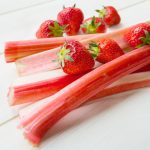Despite its vibrant green and red stalks, rhubarb might be one of the most overlooked plants in the garden.
An acquired taste, it looks like celery and has a tart tang, yet is used in many dessert recipes, from compote to pie. As with cranberries, rhubarb needs quite a bit of sweetness to appeal to the palate. It’s often paired with strawberries to cut down on the amount of sugar needed.
Why should it be on your menu? Rhubarb is an excellent source of vitamin C, lutein and calcium. It’s also very low in calories with just 11 calories per stalk. So if you’ve never had it before, it’s time to give it a try.
You’re likely to find rhubarb at farmers’ markets as well as in the produce section of your favorite store. When shopping for rhubarb, look for brightly colored, firm and straight stalks. Important: Only the stalks are edible. Even if cooked, the leafy tops have a toxin that’s poisonous. If still attached, leaves shouldn’t look wilted. Cut them off and throw them away once home. Then wash the stalks and place in the fridge for up to a week.
One simple way to sample rhubarb is to cook it the way you would apples for applesauce.
Classic Rhubarb “Sauce”
- 1 pound rhubarb, trimmed
- 2 tablespoons honey
- Water as needed
Cut the stalks into 1-inch pieces for faster cooking. Place the chunks in a large stainless steel pan (because rhubarb is very acidic, avoid using copper and aluminum). Add the honey and just enough water to cover.
Bring to a boil over high heat. Reduce the heat to a simmer and cook 10 to 12 minutes until a thick sauce forms. Cool completely, then refrigerate for at least 1 hour before serving.
Yield: 1 cup
More information
The U.S. Department of Agriculture has links to all types of information on rhubarb — from how to grow it yourself to how to make preserves.
Source: HealthDay
Copyright © 2025 HealthDay. All rights reserved.





-300x169.jpg)










